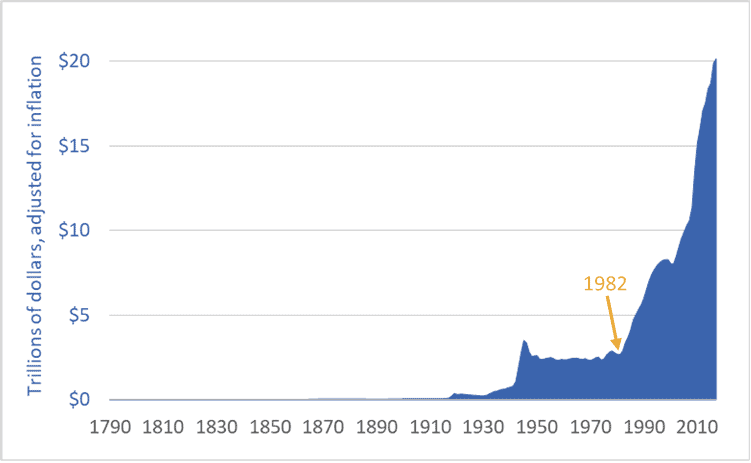Bang! Last week, US national debt broke through the $20 trillion mark. As I noted in a previous post (link here), debt of this magnitude works out to about $250,000 per hypothetical family of four.
Moreover, US national debt is rising faster than at any time in history. Adjusted for inflation, the debt is seven times higher than in 1982 ($20 trillion vs. $2.9 trillion). Indeed, it was in 1982—not 2001 or 2008—that US government debt began its unprecedented (and probably disastrous) rise.
The graph below shows US debt over the past 227 years. The figures are adjusted for inflation (i.e., they are stated in 2017 US dollars).

It’s important to understand what is happening here: the US is transferring wealth from the future into the present. The United States government is not merely engaging in some Keynesian fiscal stimulus, it is not simply borrowing for a rainy day (or 35 years of rainy days), it is not just taking advantage of low interest rates to do a bit of infrastructural fix-up or job creation, and it is not just responding to the financial crisis of 2008. No. The US government, the nation’s elites, its corporations, and its citizens are engaging in a form of temporal imperialism—colonizing the future and plundering its wealth. They are today spending wealth that, if this debt is ever to be repaid, will have to be created by workers toiling in decades to come.
You cannot understand our modern world unless you understand this: Fossil-fueled consumer-industrial economies such as those in the US, Canada, and the EU draw heavily from the future and the past.
We reach back in time hundreds-of-millions of years to source the fossil fuels to power our cars and cities. We are increasingly reliant on hundred-million-year-old sunlight to feed ourselves—accessing that ancient sunshine in the form of natural gas we turn into nitrogen fertilizer and enlarged harvests. At the same time, we irrigate many fields from fossil aquifers, created at the end of the last ice age and now pumped hundreds of times faster than they refill. We extract metal ores concentrated in the distant past. And the cement in the concrete that forms our cities is the calcium-rich remnants of tiny sea creatures that lived millions of years ago. We have thrust the resource-intake pipes for our food, industrial, and transport systems hundreds-of-millions of years into the past.
We also reach forward in time, consuming the wealth of future generations as we borrow and spend trillions of dollars they must repay; live well in the present at the expense of their future climate stability; deplete resources, clear-cut ecosystems, extinguish species, and degrade soils and water supplies. We consume today and push the bills into the future. This is the real meaning of the news that US national debt has now topped $20 trillion.
Graph sources: U.S. Department of the Treasury, “TreasuryDirect: Historical Debt Outstanding–Annual” (link here)

